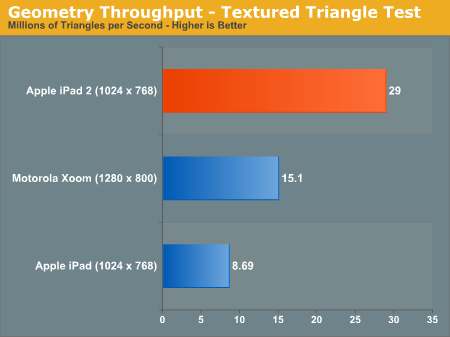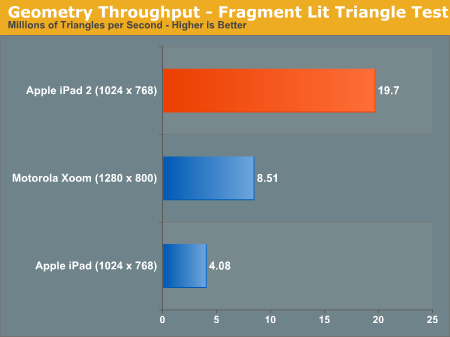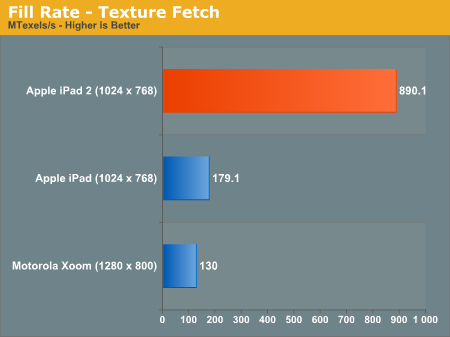Apple iPad 2 GPU Performance Explored: PowerVR SGX543MP2 Benchmarked
by Anand Lal Shimpi on March 12, 2011 3:04 PM EST- Posted in
- Smartphones
- Apple
- iPad
- GLBenchmark
- iPad 2
- Mobile
- Tablets
Earlier this morning we published our first impressions on Apple's iPad 2, including analysis on camera quality and a dive into the architecture behind Apple's A5 SoC. Our SoC investigation mostly focused on CPU performance, which we found to be a healthy 50% faster than the A4 in the original iPad - at least in web browsing. We were able to exceed Apple's claim of up to 2x performance increase in some synthetic tests, but even a 50% increase in javascript and web page loading performance isn't anything to be upset about. We briefly touched on the GPU: Imagination Technologies' PowerVR SGX 543MP2. Here Apple is promising up to a 9x increase in performance, but it's something we wanted to investigate.
Architecturally the 543MP2 has more than twice the compute horsepower of the SGX 535 used in Apple's A4. Each shader pipeline can execute twice the number of instructions per clock as the SGX 535, and then there are four times as many pipes in an SGX 543MP2 as there are in a 535. There are also efficiency improvements as well. Hidden surface removal works at twice the rate in the 543MP2 as it did in the 535. There's also a big boost in texture filtering performance as you'll see below.
As always we turn to GLBenchmark 2.0, a benchmark crafted by a bunch of developers who either have or had experience doing development work for some of the big dev houses in the industry. We'll start with some of the synthetics.
Over the course of PC gaming evolution we noticed a significant increase in geometry complexity. We'll likely see a similar evolution with games in the ultra mobile space, and as a result this next round of ultra mobile GPUs will seriously ramp up geometry performance.
Here we look at two different geometry tests amounting to the (almost) best and worst case triangle throughput measured by GLBenchmark 2.0. First we have the best case scenario - a textured triangle:

The original iPad could manage 8.7 million triangles per second in this test. The iPad 2? 29 million. An increase of over 3x. Developers with existing titles on the iPad could conceivably triple geometry complexity with no impact on performance on the iPad 2.
Now for the more complex case - a fragment lit triangle test:

The performance gap widens. While the PowerVR SGX 535 in the A4 could barely break 4 million triangles per second in this test, the PowerVR SGX 543MP2 in the A5 manages just under 20 million. There's just no competition here.
I mentioned an improvement in texturing performance earlier. The GLBenchmark texture fetch test puts numbers to that statement:

We're talking about nearly a 5x increase in texture fetch performance. This has to be due to more than an increase in the amount of texturing hardware. An improvement in throughput? Increase in memory bandwidth? It's tough to say without knowing more at this point.
| Apple iPad vs. iPad 2 | ||||
| Apple iPad (PowerVR SGX 535) | Apple iPad 2 (PowerVR SGX 543MP2) | |||
| Array test - uniform array access |
3412.4 kVertex/s
|
3864.0 kVertex/s
|
||
| Branching test - balanced |
2002.2 kShaders/s
|
11412.4 kShaders/s
|
||
| Branching test - fragment weighted |
5784.3 kFragments/s
|
22402.6kFragments/s
|
||
| Branching test - vertex weighted |
3905.9 kVertex/s
|
3870.6 kVertex/s
|
||
| Common test - balanced |
1025.3 kShaders/s
|
4092.5 kShaders/s
|
||
| Common test - fragment weighted |
1603.7 kFragments/s
|
3708.2 kFragments/s
|
||
| Common test - vertex weighted |
1516.6 kVertex/s
|
3714.0 kVertex/s
|
||
| Geometric test - balanced |
1276.2 kShaders/s
|
6238.4 kShaders/s
|
||
| Geometric test - fragment weighted |
2000.6 kFragments/s
|
6382.0 kFragments/s
|
||
| Geometric test - vertex weighted |
1921.5 kVertex/s
|
3780.9 kVertex/s
|
||
| Exponential test - balanced |
2013.2 kShaders/s
|
11758.0 kShaders/s
|
||
| Exponential test - fragment weighted |
3632.3 kFragments/s
|
11151.8 kFragments/s
|
||
| Exponential test - vertex weighted |
3118.1 kVertex/s
|
3634.1 kVertex/s
|
||
| Fill test - texture fetch |
179116.2 kTexels/s
|
890077.6 kTexels/s
|
||
| For loop test - balanced |
1295.1 kShaders/s
|
3719.1 kShaders/s
|
||
| For loop test - fragment weighted |
1777.3 kFragments/s
|
6182.8 kFragments/s
|
||
| For loop test - vertex weighted |
1418.3 kVertex/s
|
3813.5 kVertex/s
|
||
| Triangle test - textured |
8691.5 kTriangles/s
|
29019.9 kTriangles/s
|
||
| Triangle test - textured, fragment lit |
4084.9 kTriangles/s
|
19695.8 kTriangles/s
|
||
| Triangle test - textured, vertex lit |
6912.4 kTriangles/s
|
20907.1 kTriangles/s
|
||
| Triangle test - white |
9621.7 kTriangles/s
|
29771.1 kTriangles/s
|
||
| Trigonometric test - balanced |
1292.6 kShaders/s
|
3249.9 kShaders/s
|
||
| Trigonometric test - fragment weighted |
1103.9 kFragments/s
|
3502.5 kFragments/s
|
||
| Trigonometric test - vertex weighted |
1018.8 kVertex/s
|
3091.7 kVertex/s
|
||
| Swapbuffer Speed |
600
|
599
|
||
Enough with the synthetics - how much of an improvement does all of this yield in the actual GLBenchmark 2.0 game tests? Oh it's big.











219 Comments
View All Comments
jabber - Sunday, March 13, 2011 - link
For years I have been pleading for someone to take note of PowerVR.Shame its been relegated to the iPad but I hope this enables a few folks to wake up and realise that there is a good alternative to brute force rendering.
I have been a fan of the PowerVR tech since the Matrox M3D days from the mid-90s.
Please can we reintroduce this tech into the next generation of PC graphics cards so we can start to reduce power consumption and up efficiency.
The current road we are on for PC graphics isnt the right one. With PowerVR we could maybe get a 6990 capable card with the power consumption of a 5770.
Worth a try surely?
jmcb - Sunday, March 13, 2011 - link
Some Android phones used the PowerVR last year, at least one upcoming Android phone will use it this year too.Some of us Android users are fans of it from last year. I dont know if they will be using this version tho.
Aziz - Sunday, March 13, 2011 - link
It is a Super Cool Device that I don't need, honestly.Thats not to say I am not tempted, I wouldn't mind if someone if gifted it to me. Too bad none of my family members are reading this.
As far as the Xoom, I will buy one when The xoom is 399 or less.
-Tempting options for the Xoom is native HDMI out although my netbook with HDMI out on integreted intel graphics would hang up alot with trying to stream hd content to my TV so our family could watch hulu content.
-love the honeycomb idea although my android 2.2 device is a bit unpolished
Overall, there is some healthy competition. WHo will be the winners. Would love to invest my money so I can easily afford the devices. Broadcom, apple, or nvda? I have a feeling nvda will lose some of the coolness that it wrapped itself with in the last 2-3 months with tegra2.
edsib1 - Sunday, March 13, 2011 - link
Its pointless having all that graphics power anyway.To play games u need BUTTONS - and preferably also a joystick.
I have a psp anyday. I have yet to see a single decent game on a phone (any phone, ever).
I bought Asphalt 5 on Android just to check out a latest game, and its rubbish. in comparison to dedicated portables.
Remember Apple's Ipad has to be competitve for the next 12 months. The next revision of Droids will push the bar higher. Should be thankful for the battle between Droiddom and Apple for pushing tech ever higher.
Juzcallmeneo - Sunday, March 13, 2011 - link
I agree..I've tried lots of games and touchscreen buttons are a pain to use for this department. FPS is probably the worst. I do kind of like the idea of that PSP phone coming out tho.. should be interesting.mrdeez - Sunday, March 13, 2011 - link
My opinion as well.Ipad=tablet games, basic os
Honeycomb=basic gaming, options galore,power user who likes to tweak it.
I have no plans on gaming with this device only work,web,email, and reading.
vision33r - Monday, March 14, 2011 - link
Then, the ipad 1 for $349 is the best tablet for you. The cheapest and best hardware at this price level.There are no android tablet at $349 that comes close to the iPad 1 in hardware and build quality.
Every android tab south of $300 has a terrible screen or need reboots every day.
StormyParis - Sunday, March 13, 2011 - link
looking at the game pictures, the graphics don't actually change the game. a tad more eye candy, that's all. who cares ?pubjoe - Sunday, March 13, 2011 - link
"Who cares?"Ironically, mostly just the benchmark obsessed, anti-Steve Jobs Résistance.
PeteH - Monday, March 14, 2011 - link
Are you honestly saying that a drastic improvement in performance is meaningless because developers haven't yet had the chance to write apps that take advantage of it?